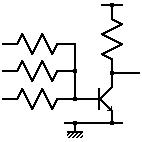 |
English | ||||||||
| Home page | Services | Past achievements | Contact | Site map |
|||||
|---|---|---|---|---|---|---|---|---|---|
| Page d'accueil | Services | Réalisations précédentes | Contact | ||||||
| Français | |||||||||
| |||||||||
|
The basic element, in Wilkinson's book, was the NOR gate, built with a single OC200 transistor and a few resistors. The circuits were soldered on metal pins nailed into peg-board, and mounted vertically so that the whole class could view the circuit from either side. |

|

|
The gate had a fan-out of three, and also had a fan-in of three, with one 10kΩ resistor per input (so-called resistor-transistor-logic, RTL). These input resistors were connected together at the base of the OC200 transistor, with the emitter connected to ground, and the collector connected to the output, and via 5.6kΩ resistor to the -12V supply (the OC200 is a PNP transistor, but the example might now be be converted to using a NPN transistor, as illustrated, or a FET). |
Wilkinson described each of the usual computer engineering blocks built from NOR gates: combinatorial logic; astable, monostable and bistable multivibrators (using 0.01μF capacitors and OA81 diodes); binary counters; decimal counters; shift registers; serial adders/subtracters; parallel adders; repeated-addition multipliers.
Memory
One weakness is that there is no real reference to stored programs. Hence, the title of the book, "Computer Models", since the resulting circuits are limited to those of the arithmetic and logic unit (ALU).
However, it would be relatively simple to extend on this, such as in the processor example that I am fond of using as a simple introduction. Then, for the memory itself, perhaps a single static RAM integrated circuit could be included now (since memory is such a repetitive, albeit large-scale, part of the computer)
Communication
Input was made via switches and old, rotary, telephone dials that were RC-debounced (4.7kΩ and 1μF).
Output was made via 6V 0.05A torch bulbs. These were driven by an NKT224 (or OC70, or OC72) emitter-follower (with a 150Ω resistor from the emitter down to ground), which was in turn driven by the NOR gate that was giving the output. (Interestingly, the NKT224 was a germanium transistor).
Conclusion
Wilkinson's simple introduction to computer circuitry is still pertinent to the design of today's microprocessors. However, it goes deeper than that. Once the book has described how to build a logic gate out of a single transistor and a few resistors, the rest of the design can be conducted at the abstract, logic-gate level. At this level, it does not matter how the logic gates are implemented. It is easy for the reader to imagine the logic gates instead being implemented with Pneumatics, Hydraulics, Babbage-like mechanics, or laser-based photonics, or even with biological DNA. Even the concepts of quantum computer hardware design become approachable. This is the justification for my assertion that this book continues to be of relevance as a first introduction to computer engineering, even today.
map